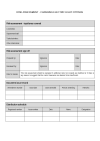Introduction to this document
Changing electric light fittings
Changing an electric light fitting must be done with care. There are several possible risks
involved, including cuts from broken glass,
burns from incorrect handling, plus the associated dangers of working at height and the possibility
of finding asbestos.
Assess the risks
If these risks are left unmanaged, they could cause accidents and potentially put you on the wrong side of the law. To ensure that this doesn’t happen, you should complete a risk assessment for your specific activities, which identifies all “significant” hazards and appropriate “reasonable” ways of reducing risks to an acceptable level.
Managing the risks
To help you identify the hazards associated with changing electric light fittings and the appropriate ways of controlling them, use our example Risk Assessment - Changing Electric Light Fittings. It covers the generic hazards associated with this type of activity and then suggests control measures to reduce risks to an acceptable level. Because carrying out this task invariably involves some work at height, we suggest you also refer to our Risk Assessment - Working at Height.
Tip. You should make sure that staff who carry out this activity are competent to do so by virtue of their training and experience.
You should ensure that your document only addresses “significant” hazards, i.e. any that could, and more importantly are likely to, cause an accident or injury.
Make your instructions clear
Don’t include activities in your document that simply don’t need to be there. Work to the principle that if there is any chance of your staff being unaware of the safe way of doing something, then you will need to make it clear in your document. Finally, always ensure that any control measures you identify and follow are decided upon the principle of “so far as is reasonably practicable”.
Note. The list of potential hazards is not exhaustive. For your risk assessment to be considered suitable and sufficient in the eyes of the law it must accurately reflect the “significant” hazards found in your workplace.
Document

17 Feb 2017


